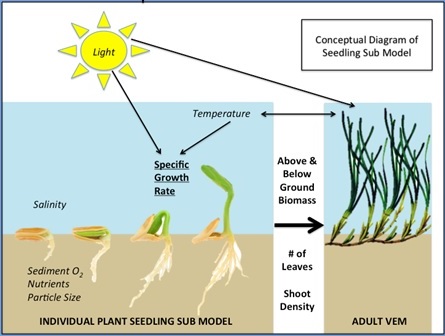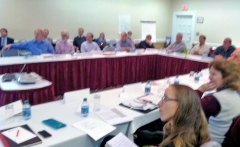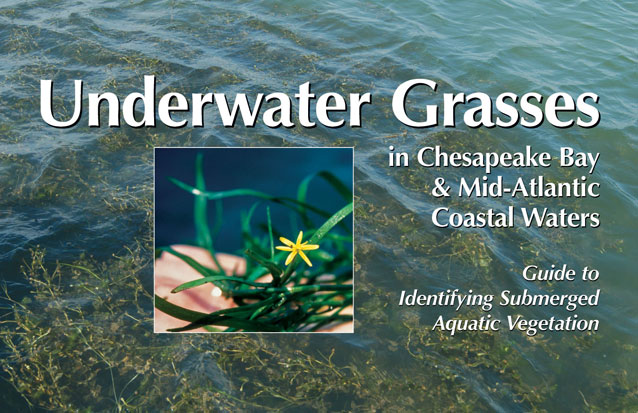Knauss legislative fellowships in Congress help build careers — and they're fun and educational. See our video and fact sheet for details.
Lost in Translation: Traversing the Boundaries of Science and Policy
As a graduate student with imminent timelines and heavy emphasis on the scientific aspects of my research, I can easily become so consumed with this work that sometimes I lose sight of the wider, practical implications of the research. I know I am not alone in admitting this. In academia, sometimes the outreach and management implications of research are inherently obvious. But other times the implications are an afterthought or come off as a bit forced. Moreover, even if we, the scientists, clearly recognize possible implications of our research, the more difficult task is translating that understanding to the project stakeholders, managers, policymakers, and ultimately one of our hardest critics: the general public.
 |
|
Here I am at my computer working with one of the many datasets for the model. I want to use the wealth of data available to help solve challenging management questions along the Eastern Shore. Credit: Cara Simpson |
So what can I do about this? How do I go about translating the science in my master’s thesis work so that it can be used to better inform and equip the management of our natural resources? To start, “translating” may not even be the most accurate term here as it implies an already direct link between science and management.
Perhaps “interpreting” is the better word to use, as there is often no single bridge between the two, like there is when translating from one language to another. Interpretation is more subjective, as will be the interpretation of my own scientific results given my knowledge of the subject. With these thoughts in mind, I want to lead you through a typical day in my office. Most recently, my days are spent sitting in front of a computer with multiple spreadsheets open. Each is filled with data and equations that I feed into our modeling software to simulate seagrass growth in coastal lagoons of the Delmarva Peninsula. I understand that this may not resonate with everyone, but what I have come to realize is that the most important component here is the “why.” Why focus on seagrass? Why seagrass in the Delmarva coastal lagoons? When someone asks me what I do, I could honestly say that I work on a computer, handle and organize large datasets, and code a model focused on seagrass growth.
Better yet however, I could deliver a response that focuses on the “why” of this project: I work on one component of a larger, collaborative research effort to develop computer modeling tools for the sub watersheds and coastal lagoon habitats along the Eastern Shore of the Delmarva Peninsula. These tools will then be made available to state, local, and county-wide managers and policy makers to help them better understand the ecosystem-based environmental changes and challenges in the face of development pressure, agricultural operations, population growth, and climate change.
In addition to describing the “why” of this project, I have also thought about its “who, what, where, and when.” When are these computer simulations important? Where and at what scale am I simulating the seagrass? What are the model’s capabilities? What are our questions and concerns that the model can help answer? With whom do I collaborate? Who cares about this type of information? Who wants this kind of model output? These are the most significant but sometimes ever-so-challenging questions to answer in comparison with my daily mathematical coding questions. As rudimentary as it may seem, this “who, what, where, when, why” exercise is even more valuable to me at this point in my graduate career than it has ever been before.
 |
| The seagrass numerical model I work with accounts for many environmental factors, notably light and temperature, that influence the growth rates of seedlings and adult plants in the coastal bays. Refining the model is one challenge, communicating it to users is another. Illustration credit: Jessica Foley |
The continuous challenge of finding ways to apply our research to solve real-world problems is why the team of principal investigators and I are using a participatory modeling approach for our Delmarva work. This effective yet underused method allows for the end users of our model to be actively involved with its construction, methodology, and various other behind-the-scene processes. Using this approach, we have solicited information from our project stakeholders to integrate scientific knowledge with local expertise. So far, my experience with this ongoing outreach effort is that the approach has the potential to be a useful platform for facing environmental problems along Delmarva that are tied to various complex, contentious management and policy concerns. I say this because the approach incorporates so many different roles and disciplines: town and county planners, scientists, engineers, policymakers, and state and non-profit organizations. Having all of these interested parties collaborate on the development of the Delmarva model adds so much strength, trust, and transparency into our work. We hope that the end users will feel comfortable running the model, navigating the results, and understanding the assumptions. In September of this year, the second of three participatory modeling workshops related to the Delmarva project will be held in Wachapreague, Virginia. I look forward to sharing my thoughts in future blog posts on the effectiveness of this participatory modeling approach in propelling our scientific research and understanding into the management and policy realm along the Delmarva Peninsula.
Photo (top left): Officials, planners, and scientists attended a "participatory modeling workshop" about new computer modeling tools that can be used to understand the coastal lagoon ecosystems along the Delmarva Peninsula. The meeting took place this past March in Ocean City, Maryland. Credit: Jeffrey Brainard
See all posts to the Fellowship Experiences blog


